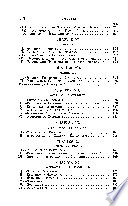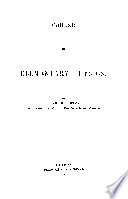 That is, if two forces are represented in direction and intensity by the adjacent sides of a parallelogram, their resultant will be represented in direction and intensity by that diagonal which passes through their point of intersection. That is, if two forces are represented in direction and intensity by the adjacent sides of a parallelogram, their resultant will be represented in direction and intensity by that diagonal which passes through their point of intersection.  Elements of Mechanics - Page 27by William Guy Peck - 1866Full view Elements of Mechanics - Page 27by William Guy Peck - 1866Full view - About this book
 | Francis Lieber, Edward Wigglesworth, Thomas Gamaliel Bradford - 1831 - 628 pages
...also their resvUni'i,. If the two forces be represented, in direction and intensity, by two contiguous sides of a parallelogram, their resultant will be represented, in direction and intensity, by its diagonal. This is called the parallelogram of forces. 3. If several forces, acting at once upon... | |
 | Encyclopaedia Americana - 1831 - 610 pages
...also their resultant). If the two forces be represented, in direction and intensity, by two contiguous sides of a parallelogram, their resultant will be represented, in direction and intensity, by its diagonal. This is called the parallelogram efforces. 3. If several forces, acting at once upon... | |
 | Adolphe Ganot - 1865 - 524 pages
...represent two forces acting at A, their resultant will be represented by AC. That is, if two forces are represented in direction and intensity by the adjacent sides of a parallelogram, their result- F'g- a ant will be represented in direction and intensity by that diagonal which passes throur/h... | |
 | Adolphe Ganot, William Guy Peck - 1871 - 516 pages
...represent two forces acting at A, their resultant will be represented by AC. That is, if two forces are represented in direction and intensity by the adjacent...represented in direction and intensity by that diagonal which passes through their point of intersection. This principle is called the ParoMelogram of Forces.... | |
 | Adolphe Ganot, William Guy Peck - 1871 - 510 pages
...if two forces are represented in direction and intensity ly the adjacent sides of a par* aUelogram^ their resultant will be represented in direction and intensity by that diagonal which passes through their point of intersection. This principle is called the Parallelogram of Forces,... | |
 | Charles Robert Cross - 1873 - 182 pages
...two Forces,, — Parallelogram Of Forces. If two forces are, represented in magnitude and direction by the adjacent sides of a parallelogram, their resultant will be represented in magnitude and direction by the diagonal. Let F, Ff, be two forces represented in magnitude and direction... | |
 | Adolphe Ganot - 1875 - 516 pages
...represent two forces acting at A, their resultant will be represented by AC. A, That is, if two forces are represented in direction and intensity by the adjacent...represented in direction and intensity by that diagonal which passes through their point of intersection. This principle is called the Parallelogram of Forces.... | |
 | Alfred Pancoast Boller - 1876 - 186 pages
...forces which they represent. What is called the parallelogram of forces is as follows : " If two forces be represented in direction and intensity by the adjacent...diagonal of the parallelogram which passes through their point of intersection." Thus in Fig. 41 the two forces are represented by the lines P and Q applied... | |
 | Adolphe Ganot - 1881 - 556 pages
...represent two forces acting at A, their resultant will be represented by A O. That is, if two forces are represented in direction and intensity by the adjacent...their resultant will be represented in direction and in- Flg ' tensity by that diagonal which passes through their point of intersection. This principle... | |
 | Edward Albert Bowser - 1884 - 538 pages
...Garnett's Dynamics, p. 10.) Hence if two concurring forces be represented in magnitude and direction by the adjacent sides of a parallelogram, their resultant will be represented in magnitude and direction by the diagonal of the parallelogram. Care must be taken in constructing the... | |
| |